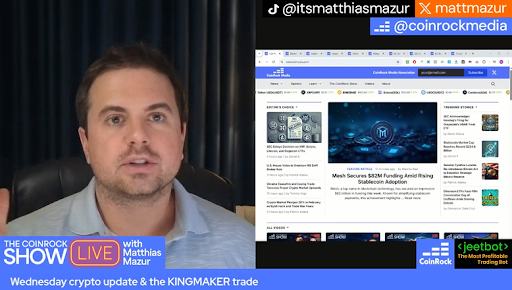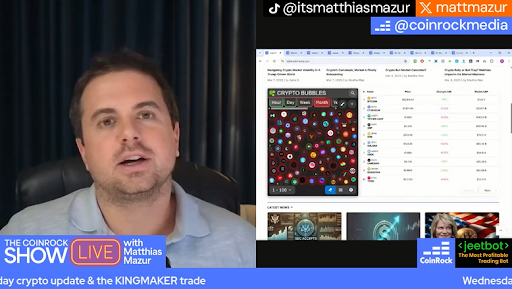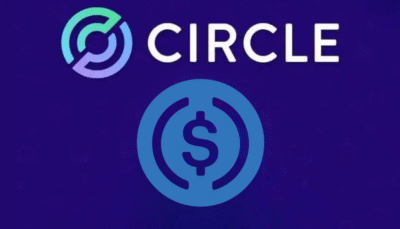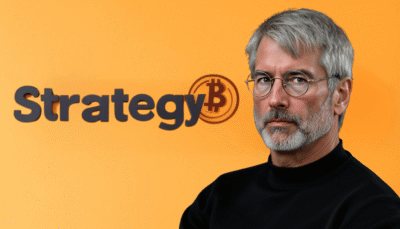In another riveting episode of The CoinRock Show, Matthias Mazur dives deep into the ever-evolving crypto market, delivering key insights on price trends, institutional movements, and the industry’s political landscape.
As always, the episode is packed with hard-hitting analysis, real-time updates, and much-needed perspective on digital asset trends.

The Market Is In Limbo
Matthias kicks off the show by addressing the choppy state of the market, with Bitcoin fluctuating between $79K and $85K, with no clear direction. While the market seems stagnant on the surface, he highlights a crucial underlying force at play—institutional investors moving behind the scenes.
Unlike retail traders who can buy or sell at will, institutions must navigate complex approval processes, often taking 6 to 12 months before executing a trade. This means that while the public sees indecision, a slow-moving storm of capital allocation is happening in the background.
Recent data supports this shift in institutional behavior. BlackRock’s iShares Bitcoin ETF (IBIT) has already surpassed $15 billion in assets under management (AUM) within three months of launch, showing massive demand from institutional players.
Additionally, in Q1 2024, over $2.3 billion flowed into crypto investment products, despite the broader market remaining uncertain. This signals that institutions quietly accumulate Bitcoin, positioning themselves for the long-term rather than reacting to short-term price swings.
Moreover, Bitcoin’s correlation with traditional assets like gold and U.S. Treasuries has strengthened, proving that major financial players now view it as a legitimate hedge against economic uncertainty.
Matthias emphasizes: “The institutions are here, and understanding how they operate is crucial. They don’t just market buy—they play the long game.“
Kingmaker Trade, A Strategic Play
One of the most talked-about insights from this episode is Matthias’ take on the “Kingmaker Trade.” He argues that the U.S. government deliberately allows the market to decline in preparation for a massive strategic move.
The process involves two key steps. First, a controlled market downturn allows major institutions and big players to enter at lower prices. Once they have positioned themselves, the Federal Reserve cuts interest rates and implements Quantitative Easing (QE) at the right time. This liquidity injection fuels a significant rally in risk assets, including Bitcoin.
Recent economic data supports this theory. The Federal Reserve’s balance sheet expanded by $300 billion in March 2024, an early signal of potential monetary easing. Additionally, historical trends show that Bitcoin has rallied an average of 220% in the 12 months following an interest rate cut, proving how closely liquidity cycles influence the crypto market.
Meanwhile, institutional accumulation is already underway—BlackRock and Fidelity’s Bitcoin ETFs have collectively attracted over $10 billion in inflows, signaling that smart money is quietly entering before the next big move. This aligns with Matthias’ view that real investors aren’t focused on daily price fluctuations but on the macro setup unfolding behind the scenes.
Matthias states: “The Kingmaker Trade isn’t an ‘if’—it’s a ‘when.’ And when it happens, it’s going to be explosive.“

Battle for Crypto Dominance
The episode also touches on how stablecoins shape the industry, as their role in global finance expands. The stablecoin market cap has surged to $234 billion, with USDT and USDC dominating the sector. However, Tether (USDT) faces mounting regulatory scrutiny from both U.S. and European authorities.
The European Union has enforced stricter compliance measures, leading significant exchanges like Binance, Crypto.com, and Kraken to announce plans to delist USDT trading pairs in certain jurisdictions.
Meanwhile, in the U.S., lawmakers are considering new proposals that could restrict offshore stablecoin issuers from accessing U.S. Treasury markets, which could tilt the balance of power in favor of USDC, a stablecoin more aligned with U.S. regulatory oversight.
At the same time, Senator Cynthia Lummis is making waves in Washington with her proposal for a U.S. Bitcoin Strategic Reserve, which would involve the government acquiring 1 million BTC over the next five years. If successful, this initiative could spark a domino effect, forcing other nations to consider Bitcoin a strategic asset.
This theory aligns with historical patterns—when El Salvador made Bitcoin legal tender in 2021, it triggered increased interest from other Latin American nations exploring similar policies.
Additionally, sovereign wealth funds in countries like Singapore and the UAE have quietly increased their exposure to Bitcoin, hinting at growing institutional acceptance.
Despite the regulatory uncertainties surrounding stablecoins and national Bitcoin reserves, Matthias emphasizes that the battle for crypto legitimacy is far from over.
While some regulations could stifle innovation or push certain players out of the market, they could also lay the foundation for broader institutional adoption, making crypto a permanent fixture in the global financial system.
Short-Term Pain, Long-Term Gain
Matthias reinforces that the current market environment is challenging, but patience is key. The Kingmaker Trade is brewing, institutions are positioning, and regulatory battles are intensifying. Those who navigate the uncertainty wisely stand to benefit massively when the tides turn.
His final words? Don’t get wrecked, stay patient, and watch for the Kingmaker moment.




